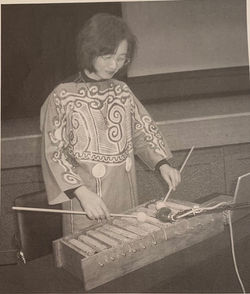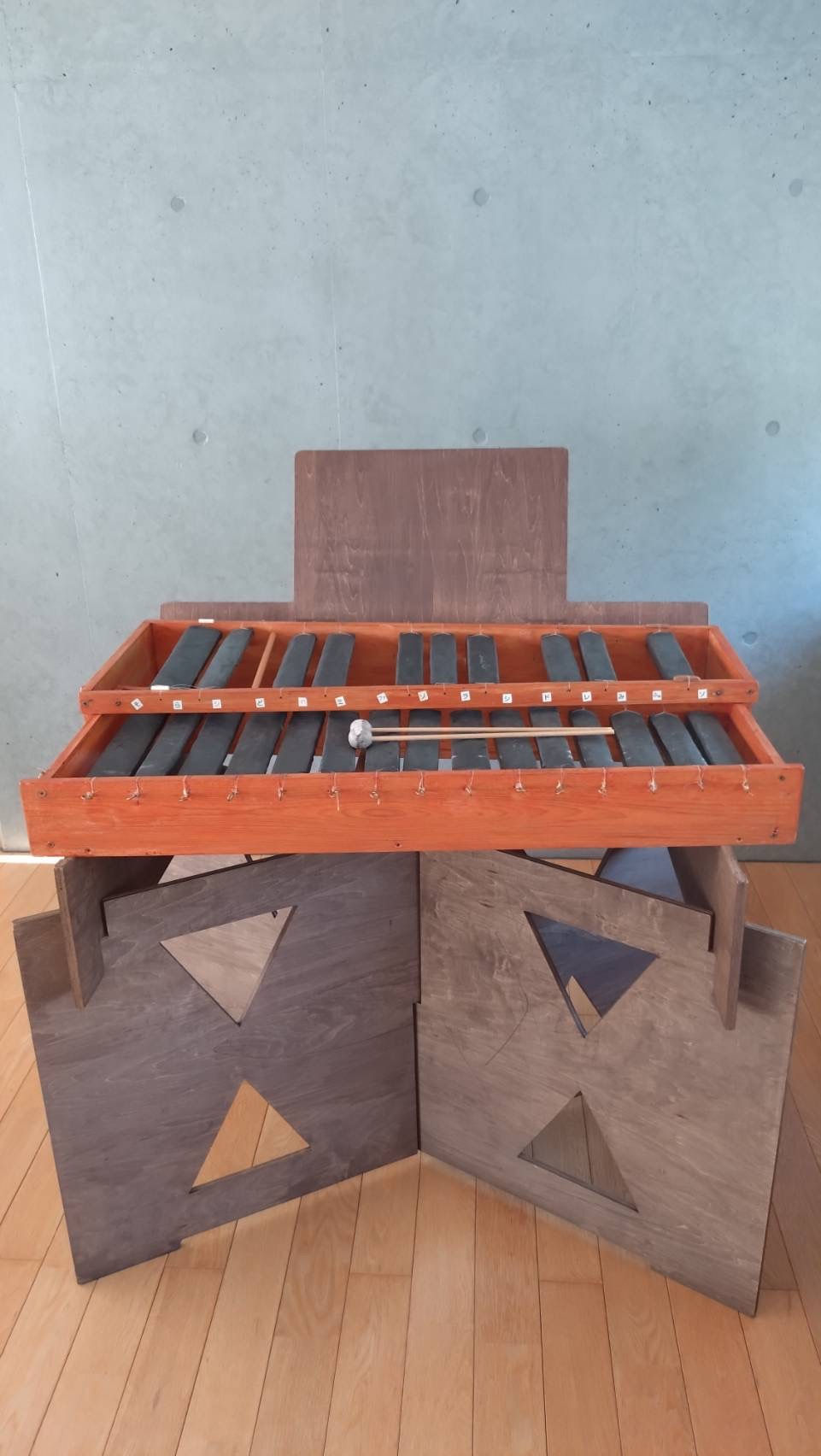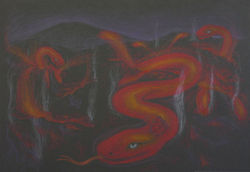

Gero Stone Suite Project Committee
組曲「下呂石物語」実行委員会
~音になる石、未来へつなぐ物語~
約十二万年前、下呂温泉街の東にある湯ヶ峰火山の噴火により生まれた下呂石。縄文時代には、矢じりや斧など石器の材料として使われ、その時代の人々の暮らしになくてはならないものでした。その後、鉄や銅などの金属の登場により使われなくなり忘れられた下呂石でしたが、現代となり、地元の考古学者たちに掘り起こされ、研究され、貴重な石だということが分かりました。そして、高く澄んだ音が出ることに着目した下呂市内外の研究家や演奏家により、下呂石は、「石琴(せっきん)」や「下呂石ハープ」という美しい音色の楽器に進化を遂げました。
私達、組曲「下呂石物語」実行委員会は、地元の子供たちや観光客に向けて、これらの楽器を使った「石琴コンサート」や、下呂石が生まれてから現在までの長い歴史をもとに描かれた『組曲「下呂石物語」~物語・挿絵付き~』の公演を行いながら、下呂石誕生の経緯、下呂石の魅力、下呂オリジナルブランドとしての価値などを伝えています。
Stone Becomes Sound — A Story for the Future.
About 120,000 years ago, the eruption of Mt. Yugamine—located east of what is now the Gero Onsen area—gave birth to a unique local stone known as Gero Stone.
During the Jomon period, it was widely used for crafting essential tools such as arrowheads and axes, playing an important role in daily life.
With the advent of metal tools made from iron and copper, Gero Stone gradually fell out of use and was forgotten.
However, in modern times, local archaeologists rediscovered and studied it, revealing its great historical and geological value.
More recently, researchers and musicians from Gero and beyond discovered that Gero Stone produces a clear and resonant sound.
This led to the creation of musical instruments such as the Gero Stone Xylophone (sekkin) and the Gero Stone Harp, giving the stone a new voice and purpose.
We, the Executive Committee for the Suite “The Gero Stone Story”, aim to share the fascinating journey of Gero Stone through performances and educational programs.
Our activities include stone concerts featuring these unique instruments, and stage presentations of the illustrated musical suite “The Gero Stone Story”, which tells the tale of the stone from its volcanic origin to the present day.
Through these efforts, we hope to convey the charm of Gero Stone, its deep connection to local history and culture, and its value as a symbol of Gero’s original identity.
The Team

Naoko Akaume
実行委員長
下呂市在住。岐阜県立加納高校音楽科、国立音楽大学卒業。あかうめ音楽教室主宰。下呂音楽振興会代表。組曲「下呂石物語」実行委員会代表。ピアノ教師として後進の指導を行う。下呂音楽振興会代表としてピアノデュオフェスティバル㏌下呂を開催。組曲「下呂石物語」実行委員会代表として、下呂の宝物である「下呂石」の周知を目的に、市内各地で石琴コンサートや組曲「下呂石物語」の公演を行っている。

中日新聞2025.9.24朝刊に掲載されました
In Gero City, Gifu Prefecture—her hometown—a musician performs on a lithophone made from Gero Stone, a volcanic rock once used for arrowheads and tools from the Paleolithic to the Yayoi periods.
Unlike metal, the sound has a warm, natural resonance. The music tells the story of the stone itself through a suite titled "The Story of Gero Stone," combining melody, narration, and illustration.
Gero Stone is a type of rhyolite formed about 100,000 years ago by the eruption of Mt. Yugamine, which overlooks the Gero Onsen area. Known for its sharp fractures and ease of shaping, it spread widely across Japan in ancient times.
The journey began about 20 years ago when a local stone researcher, Mr. Hideo Koike (now 88), introduced her to a piece of Gero Stone he had shaped using tools. She was fascinated:
“I was amazed such a stone existed. Different thicknesses produced different tones.”
With the help of a machine tuner, she worked to adjust the pitch of each piece.
At first, they performed children's songs and folk tunes at local events. Later, with support from local volunteers and music instructors, she formed an executive committee and became its chair.
In 2013, the full 25-minute suite "The Story of Gero Stone" premiered. Since then, they’ve performed it mainly at elementary schools in the area, aiming to pass on the history and beauty of Gero Stone to younger generations.
Having led a piano school for over 40 years, she now works with some of her former students on the committee.
“I hope children will remember this music—and realize how proud we can be of something so uniquely from Gero.”

Gero Stone Story" Ensemble Members
実行委員会メンバー
全員下呂市在住。
下呂石石琴、キーボード、朗読、映像、物語、衣装作成、公演構成などすべて実行委員長を中心にメンバーで提案しながら作品を作り上げています。



石琴
Gero Stone Xylophone

下呂石で作られた楽器。下呂石の会(旧 下呂石シンポジウム実行委員会)の小池秀雄氏が、下呂石で石器を作っている際に、破片が物にぶつかる時の音が綺麗なことに注目し、楽器づくりを始めました。
The instruments made from Gero stone were first inspired by Mr. Hideo Koike of the Gero Stone Association. While crafting stone tools from Gero stone, he noticed the beautiful sound produced when fragments struck objects, which led him to begin creating musical instruments.
下呂石石琴の歴史
 |  |  |
|---|---|---|
 |
初めは下呂石を幾つか並べただけのものだったが、板状に切り音階をつけて並べ11音、15音と増やし音の調整をしていきました。現在は2段で半音階の演奏が可能となりました。
現在の石琴は「日本音響研究所」の分析によって、叩いた瞬間に周波数が低いところから高い所まで非常にたくさんの音が一度に出ており、音が強くなったり弱くなったりという「振幅ゆらぎ」がみられる事がわかりました。つまり下呂石からは非常に心地よい、リラックスできる音色「癒しの音」が出ているのです。
At first, only a few pieces of Gero stone were placed together. Over time, they were cut into plate-like shapes, tuned, and arranged into 11 and then 15 notes, gradually creating a musical scale. Today, the lithophone features two rows, allowing for chromatic performances.
According to an analysis by the Japan Acoustic Research Institute, striking the Gero stone produces a wide range of frequencies simultaneously—from low to high. It also shows "amplitude fluctuations," where the sound naturally grows and fades. This creates a deeply pleasant, relaxing tone—what we call a “healing sound” from Gero stone.












小川石
Ogawa Stone



下呂石石琴を演奏するマレット
組曲「下呂石物語」Gero Stone Suite
誕生
-
約46億年前に地球が誕生した。
-
地球の形成に関与したガスや塵、氷の粒が存在した。
創生
-
約10万年前、下呂石の元となる大湯ヶ峰が噴火した。
-
地球の深い部分でのマグマ活動が下呂石を形成した。
繁栄
-
縄文時代に人々が下呂石を利用し、道具を作った。
-
矢じりや石器など、狩りや農作業に役立てられた。
空間(とき)
-
縄文時代から弥生時代への移行が描かれている。
-
稲作が伝わり、協力して豊かな村を築いた。
明日へ
-
現代において、下呂石の音色を生かした音楽が重要視されている。
-
下呂石の存在や成り立ちを広く紹介する活動が行われている。
The Story of Gero Stone
Birth
About 4.6 billion years ago, Earth was born.
At that time, the universe was filled with gases, dust, and tiny particles of ice—materials that would shape our planet.
Creation
Around 100,000 years ago, a powerful eruption of Mt. Oyugamine gave rise to Gero Stone.
Deep within the Earth, volcanic activity and magma flows formed this unique volcanic glass.
Prosperity
During the Jomon period, people began to craft tools from Gero Stone.
Arrowheads, knives, and other implements were used for hunting and early farming, supporting daily life.
Continuum
The transition from the Jomon to the Yayoi period marked the dawn of rice cultivation.
Communities grew stronger as people cooperated and built flourishing villages.
Toward Tomorrow
Today, Gero Stone continues to inspire through music made from its unique sound.
Efforts are underway to share its history, sound, and significance with the world.
Illustrations `Gero Stone Suite'
 下呂石物語01組曲「下呂石物語」 |  下呂石物語02組曲「下呂石物語」 |  下呂石物語03組曲「下呂石物語�」 |
|---|---|---|
 下呂石物語04組曲「下呂石物語」 |  下呂石物語05組曲「下呂石物語」 |  下呂石物語06組曲「下呂石物語」 |
 下呂石物語07組曲「下呂石物語」 |  下呂石物語組曲「下呂石物語」 |  下呂石物語09組曲「下呂石物語」 |
 下呂石物語10組曲「下呂石物語」 |  下呂石物語11組曲「下呂石物語」 |  下呂石物語12組曲「下呂石物語」 |
 下呂石物語13組曲「下呂石物語」 |  下呂石物語14組曲「下呂石物語」 |  下呂石物語15組曲「下呂石物語」 |
 下呂石物語16組曲「下呂石物語」 |  下呂石物語17組曲「下呂石物語」 |  下呂石物語18組曲「下呂石物語」 |








